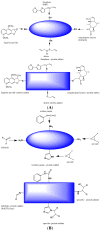Modes of Action of Herbal Medicines and Plant Secondary Metabolites
- PMID: 28930211
- PMCID: PMC5456217
- DOI: 10.3390/medicines2030251
Modes of Action of Herbal Medicines and Plant Secondary Metabolites
Abstract
Plants produce a wide diversity of secondary metabolites (SM) which serve them as defense compounds against herbivores, and other plants and microbes, but also as signal compounds. In general, SM exhibit a wide array of biological and pharmacological properties. Because of this, some plants or products isolated from them have been and are still used to treat infections, health disorders or diseases. This review provides evidence that many SM have a broad spectrum of bioactivities. They often interact with the main targets in cells, such as proteins, biomembranes or nucleic acids. Whereas some SM appear to have been optimized on a few molecular targets, such as alkaloids on receptors of neurotransmitters, others (such as phenolics and terpenoids) are less specific and attack a multitude of proteins by building hydrogen, hydrophobic and ionic bonds, thus modulating their 3D structures and in consequence their bioactivities. The main modes of action are described for the major groups of common plant secondary metabolites. The multitarget activities of many SM can explain the medical application of complex extracts from medicinal plants for more health disorders which involve several targets. Herbal medicine is not a placebo medicine but a rational medicine, and for several of them clinical trials have shown efficacy.
Keywords: bioactivity; evolutionary pharmacology; non-specific interaction; phytotherapy; plant secondary metabolite; specific interactions.
Conflict of interest statement
No conflict of interest.
Figures



References
-
- Bellamy D., Pfister A. World Medicine—Plants, Patients and People. Blackwell Publishers; Oxford, UK: 1992.
-
- Hänsel R., Sticher O., Steinegger E. Pharmakognosie—Phytopharmazie. 8th ed. Springer Verlag; Heidelberg, Germany: 2007.
-
- Mutschler E., Geisslinger G., Kroemer H.K., Schäfer-Korting M. Arzneimittelwirkungen—Lehrbuch der Pharmakologie und Toxikologie. 9th ed. Wissenschaftliche Verlagsgesellschaft; Stuttgart, Germany: 2008.
-
- Schmeller T., Wink M. Utilization of alkaloids in modern medicine. In: Roberts M.F., Wink M., editors. Alkaloids: Biochemistry, Ecology and Medicinal Applications. Plenum; New York, NY, USA: 2008. pp. 435–459.
-
- Bruneton J. Phytothérapie—Les Données de L‘évaluation. Lavoisier; Paris, France: 2002.
Publication types
LinkOut - more resources
Full Text Sources
Other Literature Sources

